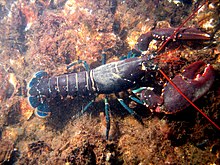歐洲螯龍蝦
| 歐洲螯龍蝦 | |
|---|---|

| |
| 科學分類 | |
| 界: | 動物界 Animalia |
| 門: | 節肢動物門 Arthropoda |
| 亞門: | 甲殼亞門 Crustacea |
| 綱: | 軟甲綱 Malacostraca |
| 目: | 十足目 Decapoda |
| 亞目: | 抱卵亞目 Pleocyemata |
| 科: | 海螯蝦科 Nephropidae |
| 屬: | 螯龍蝦屬 Homarus |
| 種: | 歐洲螯龍蝦 H. gammarus
|
| 二名法 | |
| Homarus gammarus | |
| 異名[2] | |
| |
歐洲螯龍蝦(學名:Homarus gammarus)是螯龍蝦屬的一種龍蝦,為體型較大的甲殼類,體長可長至約60公分,重約5—6公斤,但自捕龍蝦器捕獲的個體一般僅長23—38公分,重0.7—2.2公斤[3]。本種生長於水深0—150公尺的大陸棚區域(多生長於水深淺於50公尺處),偏好岩石等較硬的基質,居於洞中,並於夜間外出活動,以其他海洋無脊椎動物為食[2]。歐洲螯龍蝦與同屬的美洲螯龍蝦外形相似且親緣關係接近,兩者在人工飼養時可以雜交[4] 。
歐洲螯龍蝦最早於1758年由林奈發表描述於《自然系統》第十版,當時被分入黃道蟹屬中,名為Cancer gammarus[5];後來又有學者將其歸入螯蝦屬。1795年,弗里德里希·韋伯建立新屬螯龍蝦屬(Homarus)並以本種為模式種[6],正模標本是由利普克·霍爾特赫伊斯於1794年在瑞典外海採集,但今已不存[2]。
歐洲螯龍蝦分布於東大西洋(北至挪威北部,南至摩洛哥與亞速群島,不包括波羅的海)、地中海與黑海西南部水域[2],最北的分布地點蒂斯峽灣與福爾達峽灣已在北極圈內[7]。本種已因地理隔離而分化出四大族群,分別分布於大西洋、挪威北部[7]、地中海(特別是愛琴海)以及荷蘭沿岸部分海域[8][9],後三者因有效族群較小,為適應當地環境已累積一定程度的遺傳變異[8]。1904年至1914年歐洲殖民者可能曾嘗試將本種龍蝦與其他蝦蟹一起引入紐西蘭,但本種未在當地建立族群[10]。
歐洲螯龍蝦在歐洲被作為高級的食材[11],可賣得高價[2]。十七世紀的英格蘭民謠The Crabfish描述的應即是本種[12]。2008年共有近4400公噸的歐洲螯龍蝦被捕獲,其中近八成為在英國海域捕獲[13]。目前已有許多研究嘗試以水產養殖的方式飼養歐洲螯龍蝦[14]。
參考文獻
[編輯]- ^ Butler, M.; Cockcroft, A.; MacDiarmid, A.; Wahle, R. Homarus gammarus. The IUCN Red List of Threatened Species. 2011, 2011: e.T169955A69905303 [19 November 2021]. doi:10.2305/IUCN.UK.2011-1.RLTS.T169955A69905303.en
 .
.
- ^ 2.0 2.1 2.2 2.3 2.4 Holthuis, Lipke B. Homarus gammarus. FAO Species Catalogue, Volume 13: Marine Lobsters of the World. FAO Fisheries Synopsis No. 125. Food and Agriculture Organization. 1991: 60 [September 30, 2010]. ISBN 92-5-103027-8. (原始內容存檔於September 10, 2010).
- ^ European lobster: notes on the sizes of Homarus gammarus. British Marine Life Study Society. [October 14, 2010]. (原始內容存檔於2020-01-25).
- ^ Hauge, Marie. Unique lobster hybrid. Norwegian Institute of Marine Research. May 2010 [September 30, 2010]. (原始內容存檔於2019-10-18).
- ^ Boxshall, Geoff. Crustacean classification: on-going controversies and unresolved problems (PDF). Z.-Q. Zhang; W. A. Shear (編). Linnaeus Tercentenary: Progress in Invertebrate Taxonomy. 2007: 313–325 [2024-04-23]. (原始內容存檔 (PDF)於2023-06-14).
- ^ Official Lists and Indexes of Names in Zoology (PDF). International Commission on Zoological Nomenclature. March 31, 2010 [October 14, 2010]. (原始內容 (PDF)存檔於June 30, 2009).
- ^ 7.0 7.1 Ann-Lisbeth Agnalt; Eva Farestveit; Kaare Gundersen; Knut E. Jørstad; Tore S. Kristiansen. Population characteristics of the world's northernmost stocks of European lobster (Homarus gammarus) in Tysfjord and Nordfolda, northern Norway. New Zealand Journal of Marine and Freshwater Research. 2009, 43 (1): 47–57. S2CID 84360568. doi:10.1080/00288330909509981
 .
.
- ^ 8.0 8.1 P. A. Prodöhl; K. E. Jørstad; A. Triantafyllidis; V. Katsares; C. Triantaphyllidis. European lobster Homarus gammarus (PDF). Genetic Impact of Aquaculture Activities on Native Populations. Norwegian Institute of Marine Research: 91–98. [September 29, 2010]. (原始內容 (PDF)存檔於July 24, 2011).
- ^ A. Triantafyllidis; A. P. Apostolidis; V. Katsares; E. Kelly; J. Mercer; M. Hughes; K. E. Jørstad; A. Tsolou; R. Hynes; C. Triantaphyllidis. Mitochondrial DNA variation in the European lobster (Homarus gammarus) throughout the range. Marine Biology. 2005, 146 (2): 223–235. S2CID 83871032. doi:10.1007/s00227-004-1435-2.
- ^ G. J. Inglis; B. J. Hayden; W. A. Nelson. Are the marine biotas of island ecosystems more vulnerable to invasion?. Rob Allen; William George Lee (編). Biological Invasions in New Zealand. Volume 186 of Ecological studies. Springer Verlag. 2006: 119–135. ISBN 978-3-540-30022-9.
- ^ Davidson, Alan. Lobster. Mediterranean Seafood: A Comprehensive Guide with Recipes 3rd. Ten Speed Press. 2002: 178. ISBN 978-1-58008-451-2.
- ^ Bishop Percy's Folio Manuscript: loose and humorous songs ed. Frederick J. Furnivall. London, 1868
- ^ Fishery Statistical Collections. Global Production. Fisheries Global Information System. Food and Agriculture Organization. [September 30, 2010]. (原始內容存檔於2020-11-16).
- ^ Hinchcliffe, James; Agnalt, Ann‐Lisbeth; Daniels, Carly L.; Drengstig, Asbj∅rn; Lund, Ivar; McMinn, Jane; Powell, Adam. European lobster Homarus gammarus aquaculture: Technical developments, opportunities and requirements. Reviews in Aquaculture. 2022-03, 14 (2): 919–937. doi:10.1111/raq.12634.

